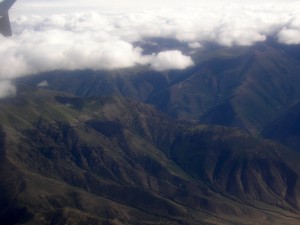Ranging from cries of protest to longing for home, the music of Tibetan exile artists creates a complex mosaic that becomes clearer in context.

Four years ago on a plane bound for Lhasa, I watched expectantly as the aircraft’s shadow passed over the verdant mountains surrounding the airport. I grew up picturing an idealized Tibet of snowcapped mountain peaks, shining bronze Buddha statues, and nomads on horseback. During my stay in Lhasa, I woke up every morning to a startlingly blue sky and fell asleep every night to the sounds of discordant singing drifting from the karaoke hall across the street from my hotel. Nothing I experienced between the open and close of my days there could be configured into a set of simple, congruent images.
The Dalai Lama’s visit to the United States this month led me to think about the complexities of my experiences in Tibet and of the Tibetan community living in exile, including its musicians. Approximately 140,000 Tibetans now live abroad, with the majority residing in India. The Dalai Lama and the Central Tibetan Administration, the exile government, have been based in the Dharamsala suburb of Mcleodganj since 1960. Over the decades since the Dalai Lama left Tibet, tension has existed between the exile administration and the Chinese government, which makes historical claims on Tibet and states that Chinese leadership has improved the quality of life there.
Rock resistance

For numerous artists born outside of Tibet, the experience of being without a country and the desire to reclaim Tibet from China are prominent messages in their music. Many of the songs by JJI Exile Brothers, one of the earliest Tibetan exile rock bands, deal with these two themes. Encouraged by their mother, who owns a restaurant in Mcleodganj, brothers Jamyang, Jigme, and Ingsel formed their band in 1998. The brothers cite musical influences ranging from Tibetan exile folk singer Techung to American blues legend Muddy Waters. Over the years, JJI Exile Brothers has maintained a strong following and has inspired many Tibetans with their message.
One of the newer Tibetan rock groups to follow in the tradition of JJI Exile Brothers is Melong Band, founded in Minneapolis in 2007. The group incorporates Himalayan regional instruments, such as the dranyen, a long-necked lute, into many of their songs. Revolt, their most recent album, was released this month in conjunction with the Dalai Lama’s visit. Tenzing Jigme, the band’s lead guitarist, has appeared on Soyala, Voice of America’s contemporary Tibetan music show, and is also the founder of the online Tibetan music radio station Bhodshey.
“Bhod Gyalo” by Melong Band
Voice of Tibet

Originally from Lhasa, singer Yungchen Lhamo has lived in exile since making an arduous trek across the Himalayas in 1989. Now based in New York, she is often called the “Voice of Tibet” and has gained significant recognition for her music, including signing on with Peter Gabriel’s Real World Records and collaborating with prominent artists such as Annie Lennox. While dealing with the hardships of exile, such as longing and displacement, Lhamo’s music is also filled with hope and encouragement for the younger generation of exiles. Lhamo is known for her solo a cappella performances, but on her last two albums has also experimented with different types of accompaniments ranging from kora to full orchestra. In 2004, she established the Yungchen Lhamo Charitable Foundation, which sponsors relief and education projects for Tibetans around the world.
It is worth noting the potential for confusion between Lhamo and Yangjin Lamu, a Tibetan singer also living in the United States. In February 2011, Lamu was awarded for her contribution to Paul Winter’s new age album Miho: Journey to the Mountain. Although she uses the Chinese transliteration of her Tibetan name, the media sometimes refers to Lamu as “Yungchen Lhamo,” including China’s central television agency in its English-language coverage of the 2011 Grammys. Lamu primarily sings a mixture of Buddhist chant and meditation music, and is popular in China and Taiwan. In addition to her music, she is the founder and president of the China Overseas Tibetan Association.
A complex mosaic
When asked about my trip to Tibet, I find that the stunning landscape is the one element that I describe consistently, followed by a narrative of my trip as jumbled as my experiences. Sadly, this beautiful plateau is at the heart of a tough sovereignty issue that impacts the Tibetans living there and those in exile. Images of Tibet’s pristine sky, mountains, and grasslands are frequently evoked in songs by exile musicians, but the perspective from which these artists sing often differs. Musicians born outside of Tibet describe a place that they have never seen, while artists like Yungchen Lhamo sing of a place that they hope to return to. Beyond rock and traditional music, Tibetan exile music is now also expanding into the realms of hip hop, folk rock, electronica, and other genres. These many voices of the Tibetan musical community form a complex mosaic that is complete only when viewed within the context of the different generations and life experiences of its artists.
“Happiness Is” by Yungchen Lhamo
Aerial photo by Sarah Lin Bhatia.
JJI Exile Brothers photo by Wen-Yan King.
Yungchen Lhamo photo by Kate Glicksberg.





